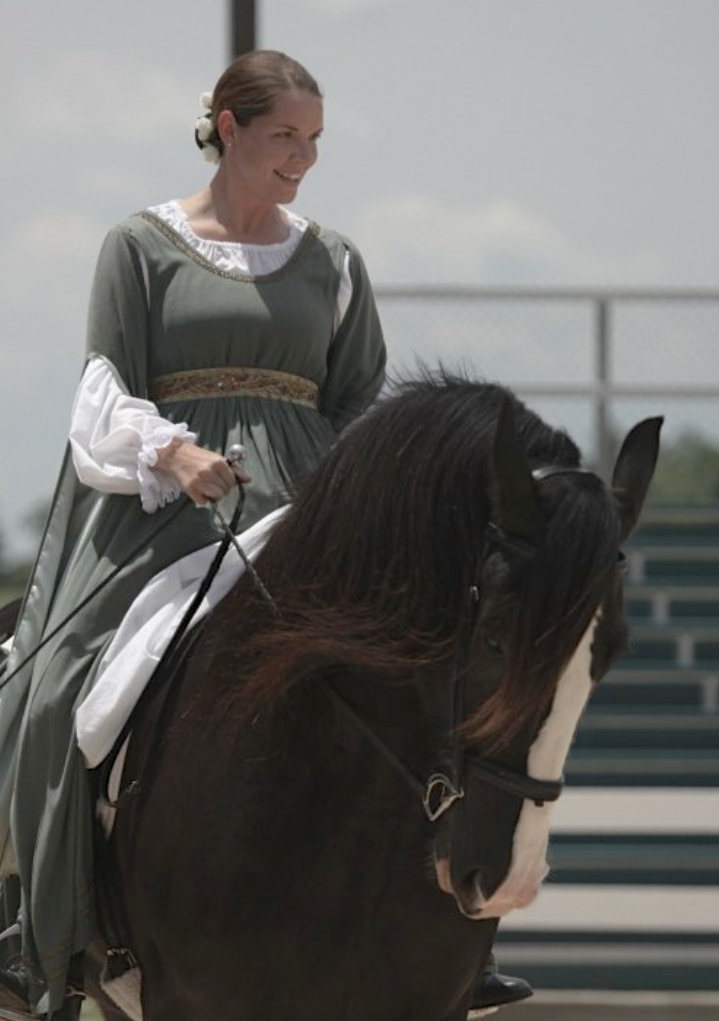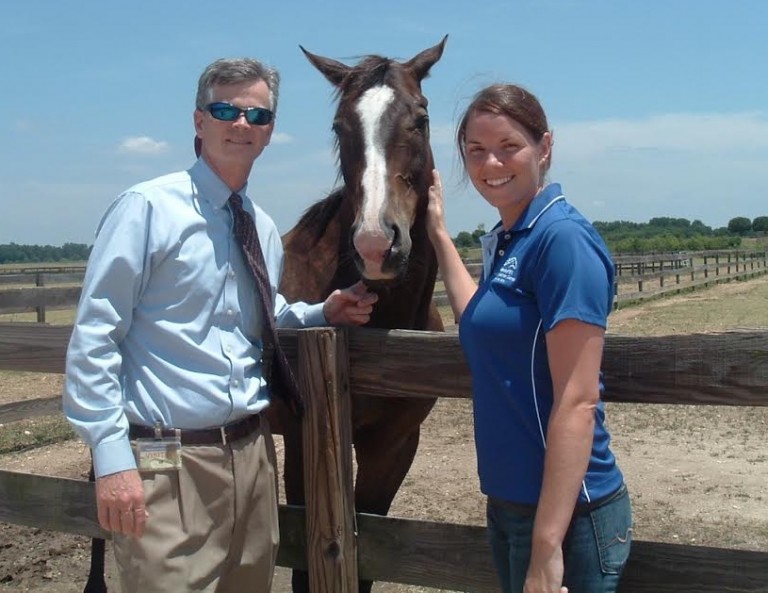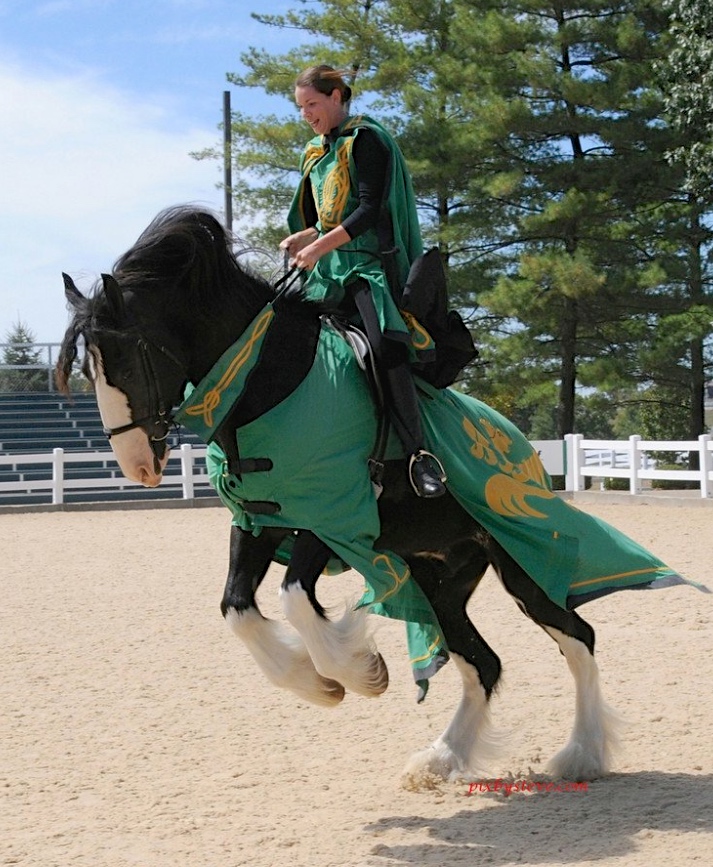
Thoroughbred Retirement Foundation Herd Manager Sara Davenport transitioned from doing breed demonstrations and management for the Kentucky Horse Park to overseeing 900 Thoroughbred ex-racehorses.
A herd of 156 Thoroughbreds spots Sara Davenport as she pulls up to the Oklahoma land where they roam across sprawling fields.
On this particular day, the Rye grass is growing thick, and the watering ponds are nearly spilling over. And as the herd manager for the Thoroughbred Retirement Foundation approaches, they gather and turn like a flock of birds, sensing no need for her assistance on this day.
“These horses are so funny,” says Davenport. “If the grass had been getting a little thin, they’d see our trailers and coming running toward us because they know we’d be moving them to better grazing. They’ll literally come running and jump onto the trailers. But they did not want to come out of their fields yesterday. The grass was thick. The ponds were high. So we literally had to herd them and corral them.”
Last month, Davenport and six others spent a total of five hours examining every horse, laying their hands on their coats, checking their teeth, and picking up each hoof and flipping their lips to read their tattoos. Their work continued with the administration of wormers to the single, largest herd of ex-racehorses in the TRF’s national herd, which numbers near 900.
Since assuming the mantle of herd manager for the nation’s oldest and largest Thoroughbred retirement farm, Davenport crisscrosses the United States checking the Foundation’s 25 farms and horses twice a year. In this week’s Clubhouse Q&A, Davenport discusses her “dream job” keeping track of all those horses and all their wants and needs.
Q: Your life with horses has had a fairytale element to it.

Sara worked for the Kentucky Horse Park doing breed demonstrations before taking over the reins as the herd manager at the Thoroughbred Retirement Foundation.
Before I came to the TRF, I worked at the Breed’s Farm in the Kentucky Horse Park riding in costumes that represented the breed. One of the horses was an English Shire; a horse once rode by knights. So we dressed them in chainmail and carried swords and rode them to theatrical music while doing sword fights. I also rode Arabians in native costumes, covering my head with native garb. It was every horse girl’s dream job, and I loved it.
Q: How did the Thoroughbred Retirement Foundation lure you away?
When the World Equestrian Games came to Lexington in 2010, I was working at the horse park helping to organize their Equine Village. We had clinics, horse shows, a petting zoo, and it was my job to help coordinate it. One of our vendors was the TRF. After the games were over, someone at the TRF approached me and said, ‘We need someone like you at the TRF.’
I started on MLK Day in 2011 as an office assistant and eventually became the herd manager.
Q: Hard work and horses were in your wheelhouse since you were a kid.

Today, Sara keeps a vast database on every Thoroughbred retired with the TRF. And she makes frequent trips to the 25 farms where they are kept. Pictured with William Cox of Wateree River Correctional Institution in South Carolina.
I grew up on a small Arabian horse farm in Abraham Lincoln’s birthplace, Hodgenville, Ky. One of my strongest memories is of the chores I did. Every single morning my parents got up and fed the horses so I could get ready for school but then I came straight home and went right to work. I fed the horses, cleaned stalls, switched their turnout and made sure everything was in order.
My friends would always talk about what they were doing after school, but I never once asked my parents if they could do my chores so I could go out with my friends. It never felt like a burden. I was supposed to take care of theses horses, and that’s what I did.
Q: How do you manage 900 horses?
The most important thing I do, primarily, is keeping the inventory on all horses up to date. I know where they are, where they’ve been, and where they’re going. At any point I can track a horse on the TRF data base and see his status.

Sara loved the breed demo work she did at the Horse Park, but finds caring for 900 ex-racehorses even more fulfilling.
I visit every farm twice a year. We have 25 farms … and every time I go to a farm I photograph every horse and save its data. At any point someone can email me and ask if we have a particular horse, and I cannot only say yes, but I can provide the latest information on him.
One of my favorite farms to visit is the Rafter G Ranch in Tulsa. It’s so funny. Greg Goin, who oversees the farm with his wife Shellie, can just whistle for the herd and they come running toward him in a stampede. To them, he’s just a big, loud member of their herd.
When I started this work, I didn’t know how much it would mean to me. Or how much I’d care about the horses. But now that I’m knee-deep, I worry about them like they’re my own horses. If there’s a snowstorm in New York or a tornado somewhere, my first thought is for the horses, and hoping that they’re safe. In a way, they’re kind of like my own horses. You can ask me about any horse, and I can tell you where he is. They’re kind of like my horses now. And, I love them.
— The TRF supports its herd through donations. Anyone interested in making a small gift may do so by clicking this link: https://trf20546.thankyou4caring.org/Make-A-Gift, or by calling the office: (518) 226-0028.


I don’t understand if they are so good at there work and care and dedication to thourbread horses then why are they at slaughter plants in Canada mexico?
Vicki:
The TRF cares for nearly 900 horses, which is a very small fraction of the numbers of horses who wind up in the slaughter pipeline. All of the horses in the TRF’s care are Thoroughbred ex-racehorses. Racehorses and all breeds wind up in the slaughter pipeline, sadly.
900 Thoroughbreds! I have trouble with just one. Thanks for taking care of the herd.
What wonderful work you and “your” farms do. Bless you all.
Sublime photo!